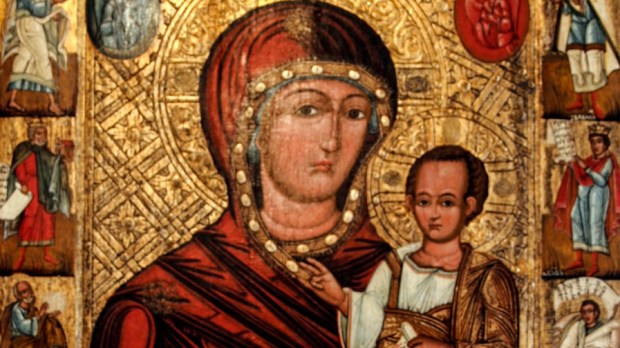Lenten Campaign 2025
This content is free of charge, as are all our articles.
Support us with a donation that is tax-deductible and enable us to continue to reach millions of readers.
Click “Launch the slideshow” in the image below for an illustrated guide:
At first, they all seemed essentially identical.
I was in a local icon museum on an assignment and I was facing a hanging panel of ten different icons of Mary Mother of God, or the Theotokos, as these icons are known, from the Greek for God-bearer. Sure, in some icons Mary’s head was tilted to the left rather than the right. And some glittered while others were more dulled with age. And certainly the relative proportions of Mary to the Christ Child varied widely.
But in terms of fundamental features they all looked the same: Mary was much larger than Christ, even if He was shown in a non-infant stage, her head was bowed, and Christ always seemed to be cradled within her embrace.
It had been a decade past my entrance into the Church, but my vestigial Protestant instincts started acting up. Why was Mary always larger than Christ?Why so many icons depicting the same thing? It seemed like so much Marian overkill.
Of course, I’ve learned to distrust such lingering Protestant instincts. So, rather than turn away from icons of Mary I put more focus into them. And I started to get it. Mary’s whole countenance was designed in such a way as to center attention on Christ, who was usually in the focal point of many of the Theotokos icons that I saw.
Learning to distinguish among the different types of Theotokos icons—there are at least five major ones based on style—helped me to see this. (Of course there are many more. One chart I found listed approximately 132 types. Some styles are associated with particular locales.)
One icon really illustrated how Mary always leads us to Christ. In this style, also known as Mother of God Praying, Mary’s arms are held up in prayer, instead of in a maternal embrace. In these icons Christ is suspended in the center, often in a circle, near or over where Mary’s heart would be. In a sense, it was like there was an icon within an icon.
In some versions of these icons, the angle of Mary’s arms suggests not just prayer but an act of revelation. Her arms are held back as if to provide an unobstructed view of Christ.
The other icons started to differentiate themselves. One of the simpler types is the Hodigitria icon, translated as She Who Shows the Way. In this depiction, Christ rests on one side of Mary while her free hand points to Him. Mary’s relative largeness catches our attention only so that it might be concentrated on Christ.
And so it is with the other types of Theotokos icons. In the Eleousa icon, the motherly love of Mary towards Christ and His reciprocal filial affection towards her are stressed. One other common type shows Mary enthroned, with Christ also enthroned within her.
These icons underscore a fundamental truth: Mary’s identity does not exist apart from Christ. She is never a mother without a Son, a queen without a King, or an indicator of the way without a Way to point towards.
This sets Mary radically apart from all other divine mothers of the ancient world, whose identity was only loosely or incidentally connected to their famous sons. One struggles to think of any maternal figure from ancient Greek or Roman myth where the mother is always depicted with her son. Rather it is easy to visualize them without their sons. Their identity is comprehensible as individuals. (I’ve previously made this point here.)
Such a thing is unthinkable for Mary: she is always with Christ. Her whole existence is oriented towards Him.
And, likewise, in contemplating these icons we are called to become like Mary—to embrace Christ, to make him the center of our whole existence, and to let Him reign over our hearts.
(A note on sources: I’m particularly thankful to these online guides here, here, and here for assistance in helping me to appreciate the different styles of Theotokos icons. I also relied on these for the slideshow captions.)

